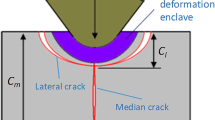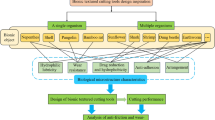Abstract
Considering the relatively poor surface and subsurface quality of workpieces that are ground by coarse-grained grinding wheels, the nanosecond ultraviolet laser micro-structuring of coarse-grained diamond grinding wheels and the grinding performance of micro-structured grinding wheels were investigated in this study. In addition, the effect of two processing sequences on the topographical characteristics of the grooves and the effect of the groove angle (α) on the surface roughness (R a ) of the ground workpiece were explored. Furthermore, the surface quality of workpieces that were ground by micro-structured (V-shaped and W-shaped patterns) and non-structured diamond grinding wheels and the grinding ratio (G) of the grinding wheels were comparatively analyzed. The results demonstrate the following: Compared with the grinding wheel that was subjected to micro-structuring followed by sharpening, the surface of the grinding wheel that was subjected to sharpening followed by micro-structuring had a more integral groove structure. Neither an overly large α nor an overly small α was favorable for improving the surface quality of the workpiece that was ground by a micro-structured grinding wheel. When α = 60°, the minimum R a of the workpiece was attained. The R a of the workpieces that were ground by the grinding wheel with a V-shaped pattern (grinding wheel A) was 17–31% less than the R a of the workpieces that were ground by the non-structured grinding wheel (grinding wheel C). The R a of the workpieces that were ground by the grinding wheel with a W-shaped pattern (grinding wheel B) was 32–41% less than the R a of the workpieces that were ground by grinding wheel C. The grinding performance of the micro-structured grinding wheels was related not only to the geometric parameters of the grooves but also to the micro-structure pattern. The W-shaped pattern was superior to the V-shaped pattern in terms of cooling and chip removal. Grinding wheel A and grinding wheel B had similar abrasion resistance, which were 26% less and 23% less than the abrasion resistance of grinding wheel C, respectively.
Similar content being viewed by others
References
Brinksmeier E, Mutluguenes Y, Klocke F, Aurich JC, Shore P, Ohmori H (2010) Ultra-precision grinding. CIRP Ann-Manuf Techn 59:652–671. doi:10.1016/j.cirp.2010.05.001
Heinzel C, Rickens K, Trumpold H (2009) Engineered wheels for grinding of optical glass. CIRP Ann-Manuf Techn 58:315–318. doi:10.1016/j.cirp.2009.03.096
Lu YJ, Xie J, Si XH (2015) Study on micro-topographical removals of diamond grain and metal bond in dry electro-contact discharge dressing of coarse diamond grinding wheel. Int J Mach Tool Manu 88:118–130. doi:10.1016/j.ijmachtools.2014.09.008
Zhao Q, Guo B (2015) Ultra-precision grinding of optical glasses using mono-layer nickel electroplated coarse-grained diamond wheels. Part 2: investigation of profile and surface grinding. Precis Eng 39:67–78. doi:10.1016/j.precisioneng.2014.07.007
Zhao Q, Guo B (2015) Ultra-precision grinding of optical glasses using mono-layer nickel electroplated coarse-grained diamond wheels. Part 1: ELID assisted precision conditioning of grinding wheels. Precis Eng 39:56–66. doi:10.1016/j.precisioneng.2014.07.006
Aida H, Takeda H, Kim S, Aota N, Koyama K, Yamazaki T, Doi T (2014) Evaluation of subsurface damage in GaN substrate induced by mechanical polishing with diamond abrasives. Appl Surf Sci 292:531–536. doi:10.1016/j.apsusc.2013.12.005
Walter C, Komischke T, Kuster F, Wegener K (2014) Laser-structured grinding tools—generation of prototype patterns and performance evaluation. J Mater Process Tech 214:951–961. doi:10.1016/j.jmatprotec.2013.11.015
Khangar A, Dahotre NB (2005) Morphological modification in laser-dressed alumina grinding wheel material for microscale grinding. J Mater Process Tech 170:1–10. doi:10.1016/j.jmatprotec.2005.04.087
Li HN, Axinte D (2016) Textured grinding wheels: a review. Int J Mach Tool Manu 109:8–35. doi:10.1016/j.ijmachtools.2016.07.001
Guo B, Zhao Q, Fang X (2014) Precision grinding of optical glass with laser micro-structured coarse-grained diamond wheels. J Mater Process Tech 214:1045–1051. doi:10.1016/j.jmatprotec.2013.12.013
Guo B, Zhao Q, Yu X (2014) Surface micro-structuring of coarse-grained diamond wheels by nanosecond pulsed laser for improving grinding performance. Int J Precis Eng Man 15:2025–2030. doi:10.1007/s12541-014-0559-7
Deng H, Deng Z, Li S (2017) The grinding performance of a laser-dressed bronze-bonded diamond grinding wheel. Int J Adv Manuf Tech 88:1789–1798. doi:10.1007/s00170-016-8902-z
Author information
Authors and Affiliations
Corresponding author
Rights and permissions
About this article
Cite this article
Deng, H., He, J. A study of the grinding performance of laser micro-structured coarse-grained diamond grinding wheels. Int J Adv Manuf Technol 93, 1989–1997 (2017). https://doi.org/10.1007/s00170-017-0639-9
Received:
Accepted:
Published:
Issue Date:
DOI: https://doi.org/10.1007/s00170-017-0639-9




